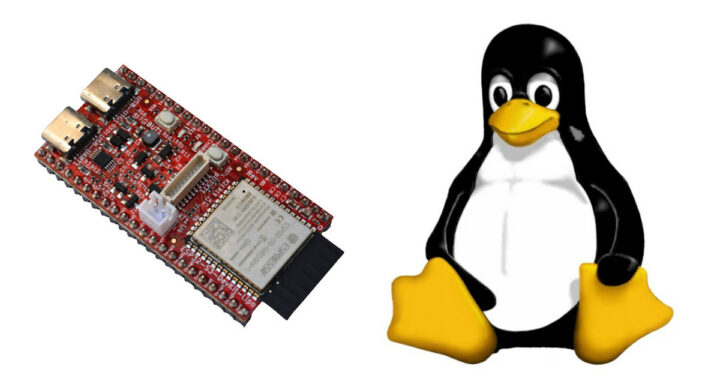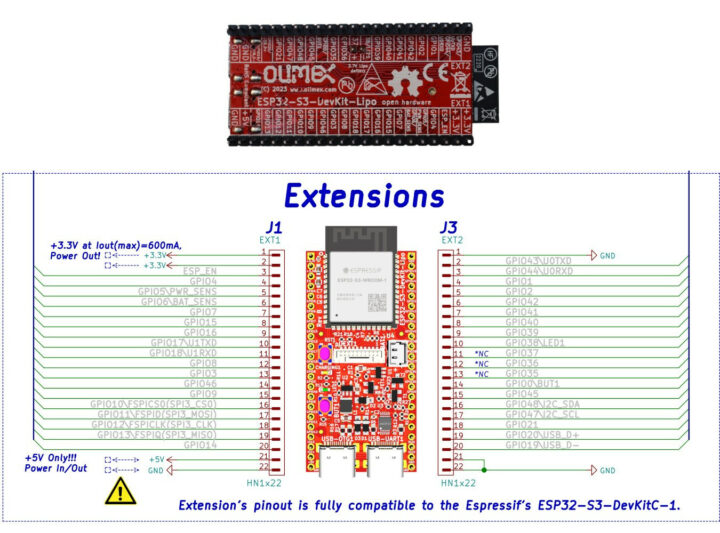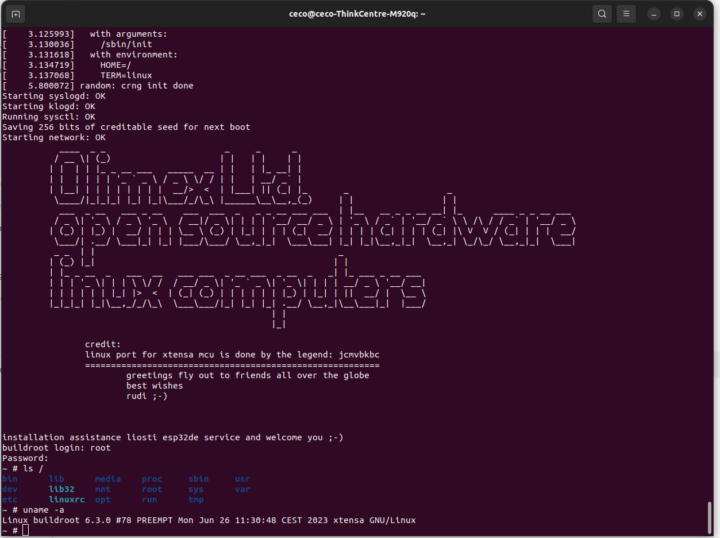Olimex ESP32-S3-DevKit-LiPo is a new open-source hardware ESP32-S3 board with 8MB flash, 8MB PSRAM, as well as LiPo battery and JTAG support that can run Linux 6.3, or the more traditional Arduino or MicroPython firmware.
The board is based on the ESP32-S3-WROOM-1-N8R8 module, features two USB-C ports for power, programming, and JTAG debugging, plenty of expansion with two rows of I/Os plus a pUEXT connector, Reset and Boot buttons, and a couple of LEDs.
ESP32-S3-DevKit-LiPo specifications:
- Wireless module – Espressif ESP32-S3-WROOM-1-N8R8 with
- SoC – ESP32-S3 dual-core LX7 microprocessor @ up to 240 MHz with Vector extension for machine learning, WiFi 4 & Bluetooth 5 LE/Mesh
- Memory – 8MB OSPI PSRAM
- Storage – 8MB QSPI flash
- PCB antenna
- Dimensions – 25.5 x 18.0 x 3.1 mm
- USB
- 1x USB Type-C OTG port also used for JTAG/Serial
- 1x USB Type-C port for USB-serial programming and power
- Expansion
- 2x 22-pin GPIO headers
- pUEXT connector
- Misc
- Green Status LED, Yellow Charge LED
- Reset and User button
- Power Supply
- 5V via USB-C port
- 2-pin connector for LiPo battery with LiPo charger
- Automatic power supply switch between USB and LiPo
- External power sense
- Battery measurement
- Dimensions – 56 x 28 mm
With two 22-pin headers and an additional pUEXT connector, Olimex’s latest board is also one of the third-party ESP32-S3 boards with the most I/Os. As mentioned in the introduction, the board is open-source with KiCAD hard design files, a user manual, and a binary Linux image available on GitHub. I just wish they could upload higher-resolution photos of their boards…
But you can also build the Linux image yourself by following the instructions using the linux-xtensa kernel by Max Filippov (jcmvbkbc). Those were successfully tested by Rudi (ESP32DE) on the ESP32-S3-DevKit-LiPo board who then shared the image with Olimex.
It should also work on other ESP32-S3 boards provided they have enough flash and PSRAM, and Rudi also tested Linux on the M5Stack CoreS3 devkit also loading the MicroPython package in Linux and running some simple scripts. It’s likely many features of the ESP32-S3 microcontroller won’t work under Linux, but WiFi does seem to work when used with ESP-Hosted.
Olimex has just started to sell the ESP32-S3-DevKit-Lipo for 12 Euros on their online store.

Jean-Luc started CNX Software in 2010 as a part-time endeavor, before quitting his job as a software engineering manager, and starting to write daily news, and reviews full time later in 2011.
Support CNX Software! Donate via cryptocurrencies, become a Patron on Patreon, or purchase goods on Amazon or Aliexpress








“It should also work on other ESP32-S3 boards provided they have enough flash and PSRAM” – I used the YD-ESP32-S3-N16R8 just changing IDF to 16mb flash – https://www.aliexpress.com/item/1005004025123046.html
When you think about it, dual-core 240 MHz, 8MB RAM, 16MB flash, wifi, Linux… It starts to be big for a microcontroller! But it could also be a right approach to get rid of the horribly bogus software stacks often found on such devices.
BTW, I love this statement on the aliexpress shop above: “beware of imitations; this product is patented, copying is not permitted”. Fun for something that in itself is already a copy of what all others have been doing for years!
No MMU, so this is uC-Linux, I take it? I think I ran that on an XT once for fun and then later on a Nintendo DS also for fun. Never used it for anything serious.
Well, esp32-s3 does seem have a basic mmu, but not sure if it’s used here.
https://docs.espressif.com/projects/esp-idf/en/latest/esp32s3/api-reference/system/mm.html
It’s not. It’s very basic and useful for some simple memory protection, but not for a VM paging OS like Linux. A lot of microcontrollers have simple MMUs like this one if they want to be used in any kind of task that requires a degree of reliability. You need to be able to protect important tasks from others and memory protection is one way to go about it.
So what is pUEXT? I googled it and only these boards are found.
It’s a miniature version of the Olimex UEXT connector with the same pinout as I understand it. It’s the white connector in the middle of the ESP32-S3-DevKit-LiPo board.
can’t find any pUEXT modules though, so I assume Olimex will provide some pUEXT to UEXT adapter of cable, but I was unable to find anything at this time.
I bought a few of these, did the build process and successfully flashed Linux to the esp32. However the use I wanted these for was to ssh into them over their WLAN interface and build from there. I see no wireless interface or software to configure it.
It’s not worth the effort to build such into them when I can just repurpose them under esphome in homeassistant. Nice effort but to get what I wanted on these would require something like the busybox env from OpenWRT (with its wifi support)
WiFi needs to be configured with ESP-Hosted. See the last two links in the article.
ho can i download olimexS3WROOM_N8qdR8ot.bin to the esp32-s3-devkit-lipo
using linux mint ??? I found no way to do thjis until now …
… now i found this: https://adafruit.github.io/Adafruit_WebSerial_ESPTool/
with wich i can connect the esp and download the bin-file …
… but when i connect after reboot with cutecom, i only get this one
single line / message
“<0x1b>[0;32mI (590) esp_psram: SPI SRAM memory test OK<0x1b>[0m␊” …
.. so how can i connect this linux shell ? on the esp32-S3 ?
you can use espressif flash tool gui from there tools
also you can use esptool if you work on command line.